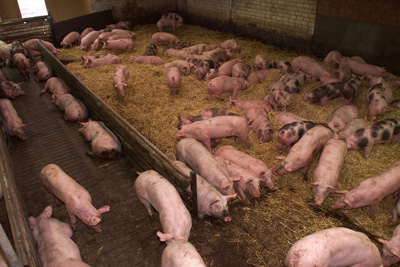Managing feeder space for pigs – a wake-up call

It’s time for a wake-up call when it comes down to feeding pigs. An impertinent remark? Or justified? In a lot of farms these days, errors are being committed on the way feeders are being managed. Some faults are large, some are smaller – but the majority may get something wrong. Here’s an update on feeding space options.
Studies of feeding behaviour suggest that even long after weaning, pigs in groups of 25 prefer to eat in groups of four to six. These groups tend to compete with other groups in the adjacent pen and try to eat from each other’s uptake area. This stimulates and increases feed intake, shortens feeding time and lowers trough wastage.
This article sets out some ground rules, most of which are in the pig production literature. However too many producers only seem to be hazily aware of them. Or if so, then many seem to be patently not following them.
Does correct feeder space matter? Very much so. There is now sufficient evidence from careful research to estimate what poor feeder management costs. Here are a few examples.
Undersupply
Too little on offer slows growth, we all know that – but how much? Walker and Morrow (1994) reported 7.4 days longer to reach slaughter compared to ideal throat gap settings (the space or gap, usually adjustable, between the feed in the hopper and the trough below). This will equal 9 kg less kg of meat sold per tonne of feed (MTF), from 30-100 kg. In economic terms today this is equivalent to the feed costing €16.50 (10%)/ tonne more.
Stress
Again, too little food on offer is bound to raise stress. The same workers showed that queueing at feeders with the throats too restricted nearly doubled, with eating time/ pig per 24 hrs rising from 78 to 110 minutes/ day. This worsened feed conversion rates (FCR) by 3.4% and resulted in a MTF of 17 kg lower – a substantial equivalent rise in growing food cost of €30.60 (17%).
Oversupply
The Irish Teasgasc centre showed that when too much food was allowed from ad-lib feeders, the difference they found between their over-generous and adequate throat settings would reduce MTF (30-100 kg) by 18 kg, equivalent to a feed price rise of 32% per tonne. Of 38 farms I visited recently, nine were allowing (far) too much food into the trough or on to the plate.
Access
So much for correct adjustment of feed allowance – what about the pig’s ability actually to access the feed?
Current advice is given in Tables 1 and 2. Not reaching these advised feeder spaces/ pig by 15% up to 50 kg liveweight reduced slaughter pig MTF (50 – 108 kg) by 15 kg. Even reducing it to 10% still cost 9 kg MTF at slaughter. This suggests that the well-published growth and FCR penalties of overstocking must involve an inadequate feeder space effect contributing to the cost of overcrowding which myself and others have measured.An interesting spin-off from the above line of thought involves providing an extra feeder for a (ten-day?) period after weaning. We did this in nursery pens containing 20-28 weaners (see Table 3).
Occupancy space
Canadian work by L. Smith and others in 2009 suggests that feeder occupancy of 80% at any one time during daylight hours is probably best. Where this 20% unoccupancy level was denied, FCR worsened between 2% and 8%. The moral here for the stockperson is to attempt to monitor the amount of space in the feeders not occupied and set the throat accordingly to try to achieve a 20% unoccupancy level at any one time.
Eating time
Pellets are eaten 12-15% faster than meal; moistening meal seems to remove this difference but not if too many ‘fines’ are present, so grist quality is critical. Small pigs eat their fill (largely based on energy satiation) 10% slower than older pigs.
Pigs fed fully wet by pipeline (i.e. CWF) eat fastest of all – if given enough shoulder space in pulse-fed long troughs. This is another pitfall, as modern genes are growing much faster now and numbers may need to be thinned down. Wet feeder stockpersons, please note, as failure to accommodate immediately all the pigs at the trough when the delivery mechanism starts, raises weight variation at slaughter. And of course unpalatable feed has its effect, too.If a normal eating period during a day was 18 hours and the average eating time for a pig in one pen was 60 minutes across the day, then to allow for a 20% unoccupancy as the the Prairie Swine researchers found, the size of feeder should have supported 14 pigs at most. Longer eating times of 70 to 80 minutes per day would reduce this to 11 and nine pigs. Quite a difference, so a good stockperson must keep an eye on eating time which can influence stocking density.All this sounds impossibly theoretical for the busy stockperson. But it is important – so the two predominant practical factors are:
• to keep the 20% unoccupancy target in mind as you go through the barns
• not to put too many pigs in a pen relating to feeder space available.
The Big Pen concept will make these desiderata less critical and is one more reason why the concept is catching on among the more astute producers (housing firms please note!)
What about throat settings?
Getting them right during all stages of growth is also critical. Failing to keep a tight eye on throat settings every day is a global fault, concomitant with overdoing stocking density. One of these errors may happen in up to 50% of farms, whereas at about up to a quarter both will occur. The penalties of overstocking have been published elsewhere – but what about incorrect throat settings – what does this cost?
Expressed in MTF terms – as they should be these days – a trawl through the evidence for correct settings constantly maintained against the typical variations in available food supply which Walker and Morrow (1994), Gonyou (2008), Duttlinger (2008) Goodland (2009) and others have experienced, could give an average 31 kg MTF shortfall at slaughter.
At even a modest deadweight price of €1.50/ kg, this is €46.50/ tonne not secured from hoppers which oversupplied feed. And for the pigs not getting enough this was 9 kg less lean sold per tonne of food – €13.50/tonne.Observations suggest that the weighting of over- to under-supply is usually two-thirds towards oversupply and if so, then the average MTF penalty is near enough €27 per tonne of grower/ finisher food. Why express it this way – on a penalty per tonne basis? Because one feed dispenser, whether it be hopper, trough, plate, or competition feeder should suffice, say, three batches of 15 pigs each eating about 220 kg feed, or about 10 tonnes of feed put through the feeder each year. If each feeder costs say €180, then the payback would be about six months. A lot of hoppers are patched up and need replacement. The above figures show it is silly to balk at the cost of a new one.
A myth
It is sometimes said that variation in food supply in the trough or on the plate after eventual throat readjustment evens itself out at slaughter, so all this fussing of mine is academic.
This does not happen. Each day, what is wasted is wasted. What is not eaten cannot be converted into meat. There is no compensatory lean growth. Some pigs may catch up in liveweight but not in lean gain, and lean meat is what we are paid for. So correct throat settings do matter.
Piece of evidence
An example from my own experience: A large Eastern bloc farm in 2009 had four big nurseries – one of them was very well managed and another, under a different section head who was fairly new to the game, much less so.
It was obvious that there was a difference in even-ness between the two groups of pigs by 30 kg. Now the owner is a remarkable man. Instead of rushing off to bawl out the errant stockman, he agreed to leave things as they were for just one more batch of pigs so that we could try to measure, in the interests of science, any difference in the variation at slaughter between the good and not-so-good nurseries. The inexperienced stockman was especially not attending to correct throat settings, and Table 4 shows that this casual attention to this aspect was not only giving major differences in even-ness at shipping, but was costing the owner 11% in underused housing costs alone due to wider close-out times.
How much feed?
Because there are so many designs of feeders, the manufacturers should be consulted before taking any firm decisions. Pellet size and hardness, fat content, and meal grist size will also influence feed flowability and thus speed of intake, i.e. eating time. All four factors should be borne in mind when considering the following advice.
1. When introducing a trough-base feeder/ hopper for the fist time, ensure the whole trough is covered, albeit thinly. For plate feeders about two-thirds.Once all the pigs are seen to be eating well (except for weaners which may need to be kept on this ‘generous but thin’ coverage for seven days), move to…
2. Seven days to 8/9 weeks post-weaning. One thirdof the trough/ plate area covered.
3. To slaughter – not more than one quarter covered. Most of the ‘ideal’ settings in the research work which gave the best physical performance and economic results were based on this one-quarter limit through the main growing periods.
4. Wet/ dry mixture feeders need an eye kept on controlling water supply as well as the feed allowance. As with fully wet feeding, a separate fresh water source is needed elsewhere in the pen.
Two common objections
“Our feeders are too far away from the access passage to make daily alteration of the throat settings anything like feasible.”
Due to pen design it is not always possible to have the hoppers within easy reach as they should be. Several producers have made cranked arms, fixed or demountable, which ingeniously raise or lower the slides from a distance of up to 4 m from the access passage. Hopper manufacturers please note that this could be a useful optional extra?
Following on from this, one hears: “Bridging is a nuisance.”Sure – very common. When farming with Taymix’s pigs it was possible to make several short metal rods – one end with a claw, the other a rubber hammer-head. The head end was used to bang the hopper front/ sides and if this didn’t work, to scratch away with the claw end inside and outside the blockage at the slide. It only took a few seconds. Again manufacturers, please note, and by the way… producers should challenge assurances at expositions of “Our feeders don’t bridge!”
Oh yeah? Bridging tends to occur when the opposing gravitational forces of the hopper (and bulk bin) contents cancel each other out. By offsetting the sides very slightly (bulk bins slightly distorted), the forces do not oppose each other and bridging is reduced, but these irregular designs are expensive to make.











